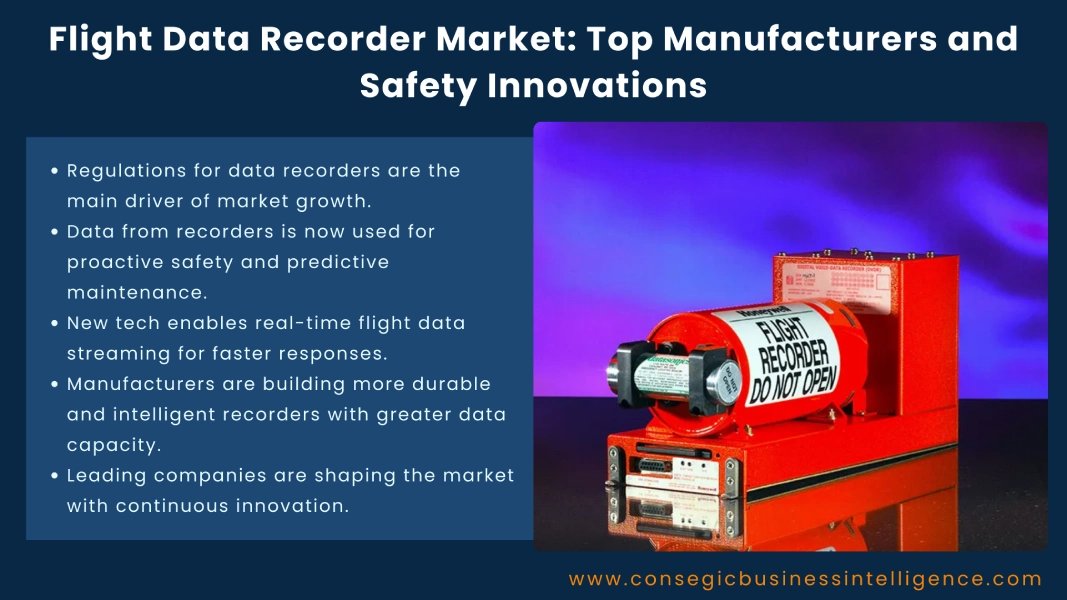Future Trends and Key Players in the Flight Data Recorder Market
Aviation safety relies on accurate and reliable data. Among the most critical tools in modern aircraft are flight data recorders (FDRs), commonly known as black boxes. These devices capture essential flight information including altitude, speed, engine performance, and cockpit conversations, that is vital for accident investigations and safety improvements. With global air traffic steadily increasing, the demand for advanced flight data recorders is growing, driven by stricter regulations, digitalization, and the need for real-time monitoring.
The flight data recorder market is shaped by leading manufacturers that supply innovative systems designed to withstand extreme conditions, while also adapting to new technological standards. Alongside them, safety innovations are transforming how aviation authorities and airlines monitor, analyze, and act on flight data.

Below are the top manufacturers and innovations shaping the future of this market.
- Honeywell International Inc.
Honeywell is a global leader in avionics and safety systems, including advanced flight data recorders. Its products integrate high-capacity memory, crash-protected modules, and real-time data streaming capabilities. Honeywell has pioneered the development of connected FDRs that can transmit critical data mid-flight, reducing delays in investigations and improving operational efficiency.
- L3Harris Technologies, Inc.
L3Harris is one of the most recognized names in the black box market. The company offers FDRs and cockpit voice recorders (CVRs) with high reliability and regulatory compliance. Its recorders feature crash-survivable memory units capable of withstanding extreme temperatures and impacts. L3Harris also invests in miniaturized recorders for smaller aircraft, broadening its market reach.
- Curtiss-Wright Corporation
Curtiss-Wright has been a long-standing provider of flight data recording systems, focusing on durability and versatility. The company offers crash-protected memory modules and integrated recorders that support both voice and data recording. Curtiss-Wright is particularly strong in military and defense aviation, where it delivers ruggedized solutions capable of meeting strict safety standards.
- Safran S.A.
Safran, through its avionics division, plays a significant role in the FDR market. The company develops recorders that comply with international standards and offer long-duration recording capabilities. Safran’s innovations include lightweight designs and enhanced connectivity, aligning with the aviation industry’s push toward fuel efficiency and digital integration.
- Universal Avionics Systems Corporation
A subsidiary of Elbit Systems, Universal Avionics is known for its cockpit solutions, including FDRs and CVRs. Its recorders integrate seamlessly with avionics suites, offering advanced features such as solid-state memory and high recording capacity. Universal Avionics is also contributing to innovations in real-time data transmission, ensuring faster access to flight-critical information.
- GE Aviation (a division of GE Aerospace)
GE Aviation leverages its expertise in aircraft engines and systems to provide advanced data recording solutions. Its FDRs are designed for next-generation aircraft, integrating with digital flight systems to capture extensive datasets. GE’s focus on predictive analytics and digital twins enhances the utility of recorded data, improving both safety and aircraft performance monitoring.
- Avionica, Inc.
Avionica specializes in flight data monitoring and wireless data transfer solutions. Its compact recorders and quick-access recorders (QARs) are widely used for real-time flight data management. Avionica’s innovations in wireless data offloading and cloud-based analytics make it a disruptive player, helping airlines optimize maintenance and safety operations.
- Dukane Seacom (a division of HEICO Corporation)
Dukane Seacom is well known for its underwater locator beacons (ULBs) that complement FDRs. These beacons are critical in locating flight recorders after accidents over water. The company continues to innovate with extended battery life and stronger transmission capabilities, supporting faster recovery of black boxes in challenging environments.
- AstroNova, Inc.
AstroNova provides flight data acquisition systems and recorders for both commercial and defense aviation. Its systems emphasize modularity and customization, making them suitable for a wide range of aircraft. The company also invests in data visualization tools that transform recorded information into actionable insights for safety and performance improvements.
- Leonardo S.p.A.
Leonardo, a major aerospace and defense company, offers FDRs and integrated avionics solutions. Its recorders are designed with advanced crash-protection features and comply with stringent international regulations. Leonardo’s growing footprint in both civil and military aviation makes it a notable contributor to the global market.
Safety Innovations Driving the Market
Beyond the manufacturers, several safety innovations are redefining the future of flight data recorders:
- Real-Time Data Streaming
Traditionally, FDRs were only accessed after accidents. Today, AI-driven and satellite-enabled recorders can transmit real-time flight data to ground stations. This allows for proactive safety monitoring and faster investigations.
- Extended Recording Capacity
New-generation FDRs offer longer recording durations, capturing hundreds of flight parameters for extended periods. This ensures more comprehensive data for regulators and investigators.
- Crash-Protected Memory Evolution
Modern devices are built to withstand extreme forces, fires, and underwater conditions. Enhanced crash-protection standards ensure that valuable data survives even catastrophic accidents.
- Integration with Predictive Analytics
FDR data is increasingly being linked to predictive maintenance systems. By analyzing performance trends, airlines can address technical issues before they escalate into safety risks.
- Lighter and More Energy-Efficient Devices
Manufacturers are designing compact, lightweight recorders that reduce aircraft weight and fuel consumption while meeting strict safety requirements.
Conclusion
The flight data recorder market is evolving rapidly, driven by both established manufacturers and groundbreaking safety innovations. Companies like Honeywell, L3Harris, Curtiss-Wright, and Safran dominate the market with advanced recorder technologies, while emerging players such as Avionica and Dukane Seacom are reshaping the landscape with specialized solutions.
With real-time data streaming, predictive analytics, and stronger crash-protection standards, flight data recorders are no longer just post-incident tools but they are becoming active contributors to aviation safety and operational efficiency. As global air traffic expands, these innovations and manufacturers will play a crucial role in ensuring safer skies and greater confidence in the aviation industry.
